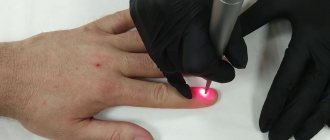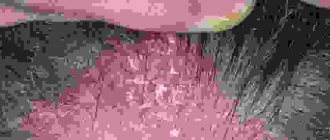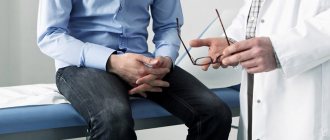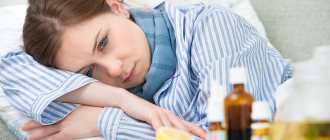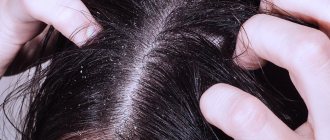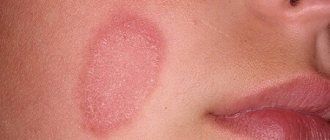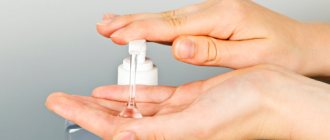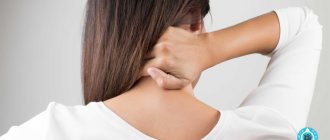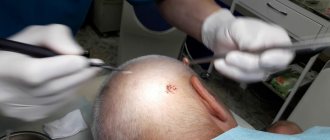Trichophytosis: symptoms of the disease
Trichophytosis of the scalp manifests itself as follows:
- small lesions appear (less than 2 cm in diameter);
- they have a reddish color, clearly defined boundaries; not prone to fusion;
- their surface may be covered with bubbles, which over time turn into crusts;
- slight itching is felt (however, it may be absent).
If there is a chronic form of trichophytosis of the scalp, the symptoms are less pronounced, only mild peeling is observed. The lesion is most often located on the back of the head. A careful examination reveals black dots of broken hair.
With the infiltrative-suppurative form of the disease, a long incubation period is observed (up to 2 months). This type of disease is characterized by the fusion of lesions, the appearance of pustules and crusts, and hair damage. In addition, dilated follicles can be seen on the surface of the lesions, from which pus pours out when pressed.
Pathogenesis
The pathogenesis of dermatophytosis is based on the virulence factors of fungi, due to their ability to secrete enzymes that destroy keratin (keratinolytic activity). The enzymes secreted by dermatomycetes and their metabolic products, as well as the contents of destroyed cells, cause an inflammatory process in the lesion, manifested by redness of the skin, itching and hair breaking. Keratinases have the ability to decompose not only keratin, but also other proteins (collagen and elastin), and it is the severity of keratinase activity that determines the characteristics of the manifestation of diseases when infected with various types of fungi. An important role in the spread of dermatomycetes is played by the presence of a specialized apparatus (perforator organs) for the directed growth of hyphae (the filamentous structure of the fungus). Thanks to this feature, the fungus grows in the direction of the intercellular junctions, which are the points of least resistance. Dermatomycetes, as a rule, do not penetrate deeper than the granular layer of the epidermis, since specific protective factors are activated at a deeper level.
The process of fungal invasion begins with the burrowing of hyphae into the skin and the release of keratinases (enzymes for the breakdown of keratins), which leads to irritation of nerve endings and, accordingly, the occurrence of itching. Dermatomycetes, loosening the cortex, cause acanthosis, parakeratosis, serous inflammation in the skin with the formation of blisters. Further, swelling occurs in the papillary/subpapillary layer, the vessels dilate, which leads to the development of polymorphic perivascular infiltration. The mycelium is usually located between the horny plates. Threads and spores of fungi can also be stuffed with hair follicles, which also undergo inflammatory changes.
Rules for cleaning an apartment or house
Since trichophytosis is dangerous for humans, you need to follow the rules for cleaning an apartment or house:
- Firstly, when doing any work in an “infected” house, you must use disposable gloves.
- Secondly, it is advisable to treat all curtains and even walls with a steam generator. We also recommend using Clinafarm smoke bombs. They are specifically designed to combat mycoses. We remind you that after using them, your home will have to be thoroughly ventilated.
If possible, add the same Ivamerol to the water when washing floors daily. When this is not available, any chlorine bleach will do. The concentration must be selected so that the product does not spoil the floor covering (i.e., use the maximum permissible concentration).
Vacuuming should also be done daily. It is advisable to change dust bags at least once every three days, destroying them by burning. All accessible parts of the vacuum cleaner must then be washed with bleach.
Ringworm in children: features of the disease
Ringworm occurs in almost 90% of children, affecting the skin of both infants and older children. Occurs in adolescence. There are many types of disease, and accurate differentiation allows for the most appropriate therapy. The help of a doctor (pediatrician, mycologist, dermatologist) in this case is irreplaceable: firstly, the doctor will make the correct diagnosis by conducting the necessary tests (lichen rashes are similar to many other skin lesions), secondly, he will prescribe appropriate treatment taking into account all indications, severity and age of the child. Each type of lichen requires a different approach and duration of use of certain means. Therefore, before treating lichen in a child, the correct diagnosis should be made. It is almost impossible to do this on your own.
The symptoms of all types of disease are similar. Ringworm in children manifests itself as scaly spots, barely noticeable at first, then more pronounced. Their color ranges from light pink to bright red, and may turn brown over time. The spots are itchy, the scales look like whitish flakes. Children, especially younger ones, may have a fever; lymph nodes enlarge. Spots appear on the neck, chest, back, shoulders, stomach and thighs; some types of fungi “live” on the head and nails.
Treatment at home
There are times when it is not possible to contact a veterinarian and you have to carry out treatment yourself, trying old-fashioned methods. In ancient times, people solved such problems on their own. For this purpose, iodine and a mixture of vegetable oil and ash were used. All affected areas were treated with a disinfectant, in this case iodine. And the gruel with ash and iodine worked like a compress. Such procedures were carried out 5-7 times a day.
To prepare the ash, newspapers, currant or raspberry branches were used. The resulting ashes were mixed with any vegetable oil that was in the house. It should be a mushy mixture. This treatment is quite effective and completely safe for the health of your pet.
With any treatment method, it is recommended to remove hair from the affected areas. This is especially important for fluffy and long-haired cats. In some cases, it is recommended to completely shave the animal so as not to miss infected areas of skin with a red rash.
Prevention
The basis of preventive measures is:
- Strict adherence to the rules of personal hygiene: do not use other people’s personal hygiene items, underwear, clothes, wash your hands thoroughly after contact with animals.
- Early (timely) identification of patients with trichophytosis with their isolation and quarantine of contact persons.
- Identification of animals with trichophytosis, carrying out deratization work.
- Carrying out current/final disinfection at infection sites (in schools, kindergartens, at home, bathhouses, hotels, hairdressers, medical institutions, dormitories, etc.).
What it is?
Infectious lesions of the dermis and its appendages caused by pathogenic fungi are called mycosis.
The types of pathogenic microorganisms are as follows:
- fungi of the genus Candida, grow in the skin and mucous membranes;
- Microsporum, Epidermophyton and Trichophyton fungi affect the skin and its appendages - hair and nails;
- the upper layers of the skin and hair follicles are affected by Malassezia furfur fungi;
- molds of the genus Mucor, Thamnidium, Rhizopus, Penicillium, Aspergillus grow in the nails and skin.
Candida and mold fungi can cause damage to the entire body.
Methods for eliminating fungal infections
Treatment of trichophytosis requires the attention of a qualified specialist. In most cases, therapy is carried out at home. To successfully combat fungus, an integrated approach is essential: medications for external and internal use, and physiotherapeutic methods are used.
Treatment of trichophytosis with medications
Modern medicine offers the dermatologist a wide selection of antifungal agents. The pathogen is usually treated in a complex manner: ointments are applied topically, and drugs are taken orally in the form of tablets or capsules.
Local and general treatment of trichophytosis - table
| Preparations for external treatment of trichophytosis | Systemic treatment of trichophytosis | ||||
| Name of medicine | Active substance | Release form | Name of medicine | Active substance | Release form |
| Exoderil | Naftifin | Solution | Itrazole | Itraconazole | Capsules |
| Keto plus |
| Shampoo | Sangviritrin |
| Pills |
| Oflomil varnish | Amorolfine | Nail polish | Exifin | Terbinafine | Pills |
| Fungoterbin | Terbinafine |
| Mikosist | Fluconazole | Pills |
| Sangviritrin |
|
| Orungal | Itraconazole | Capsules |
| Mikoderil | Naftifin |
| Binafin | Terbinafine | Pills |
| Lamisil | Terbinafine | Cream | Rumicosis | Itraconazole | Capsules |
| Exifin | Terbinafine | Cream | Diflazon | Fluconazole | Capsules |
Antifungal agents - photo gallery
Exoderil is available in the form of a cream for external use.
Oflomil is available in the form of nail polish
Lamisil is an antifungal agent for external use.
Exifine contains terbinafine
Orungal is a drug for the systemic treatment of trichophytosis
Diflazone contains fluconazole
In addition to antifungal agents, a number of additional drugs are prescribed for the treatment of trichophytosis:
- antiallergic medications (Zodak, Loratadine, Suprastin);
- drugs that improve blood circulation (Troxevasin, Trental);
- antioxidants that improve the healing of damaged skin (Actovegin);
- immunomodulators that activate the body's defenses (Thymogen, T-activin).
Thymogen improves immunity
Physiotherapy
Physiotherapy is an effective method of treating many diseases, including superficial and deep trichophytosis. Specialists prescribe the following types of procedures:
- electrophoresis with iodine allows you to disinfect the lesion;
- iontophoresis with iodine can successfully replace the previous procedure;
- inductothermy (magnetic field treatment) improves blood circulation in problem areas of the skin;
- Ultrasound therapy in the area of the nearest lymph nodes leads to the activation of one’s own immune mechanisms to fight the fungus.
Household recommendations
Treatment of trichophytosis is often a long and difficult process. The patient must follow a number of recommendations that will speed up recovery and prevent the spread of infection:
- for trichophytosis of the head, the hair is shaved once a week until complete recovery;
- if the feet are affected, it is necessary to disinfect the inner surface of the shoes once a week with a cotton swab soaked in a solution of Chlorhexidine;
Chlorhexidine solution perfectly disinfects shoes - it is necessary to use individual personal hygiene items - a comb, a towel and other linen, manicure accessories;
- shoes must be chosen that are comfortable, fit, made from natural materials, and well ventilated.
Treatment of trichophytosis in children is the task of an experienced specialist. The principles of therapy are similar to those in adults. Doses of antifungal agents used orally are calculated depending on the age and weight of the child.
Folk remedies are not used in the treatment of trichophytosis because they have not proven their effectiveness.
List of sources
- Leshchenko V. M. Fungal skin diseases. In the book: Skin and venereal diseases (a guide for doctors). Ed. Yu. K. Skripkina, V. N. Mordovtseva. M., 1999. T. 1. P. 257-311.
- Kubanova A.A., Potekaev N.S., Potekaev N.N. Guide to practical mycology. – Moscow, Financial Publishing House “Business Express”, 200 p.
- Bayazitova A.A., Bayazitova A.A., Kupriyanova-Ashina F.G., Khaldeeva E.V., Ilyinskaya O.N. Primary pathogens - Pathogens of superficial mycoses // International Journal of Applied and Basic Research. – 2015. – No. 11-2. – pp. 241-248.
- Medvedeva T.V. Trichophytosis: modern ideas about the etiology, clinical picture, features of diagnosis and therapy / T.V. Medvedeva, V.B. Antonov, L.M. Leina, T.S. Bogomolova // Klin. dermatology and venereology. - 2007. - No. 4. - P. 70–74.
- Rodionov A.N. Fungal skin diseases (Guide for doctors) St. Petersburg: Peter. 1998. – 288 p.

